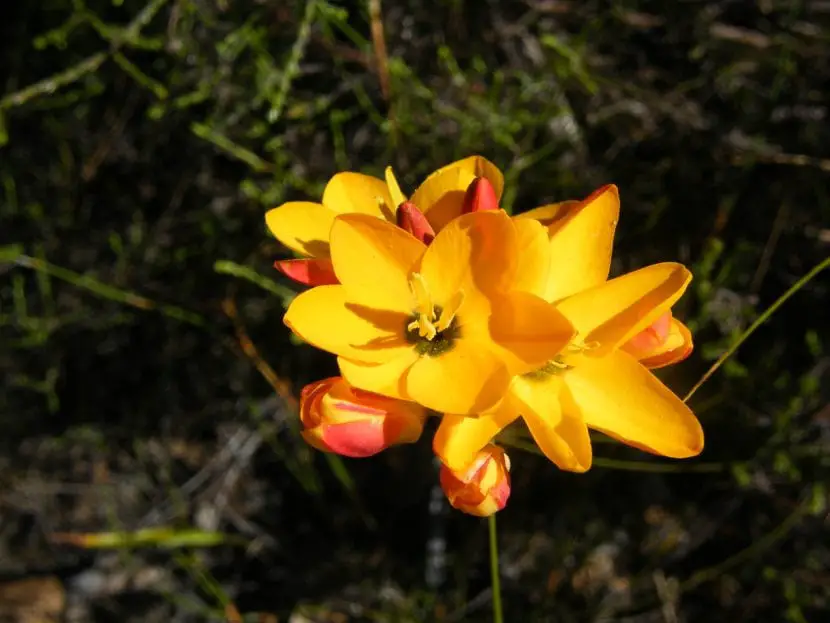
If you would like to decorate your patio or garden with little-seen bulbs without having to worry about their maintenance, we encourage you to get a few of the botanical genus Ixia. It produces so many flowers of such vivid colors, that it will surely quickly become the joy of the home.
In addition, hardly requires spaceso you can have it wherever you like it the most.
Characteristics of the Ixia

Our protagonist it is a perennial plant, that is, it lives several years, and is bulbous native to South Africa. It belongs to the botanical family Iridaceae. The leaves grow in the form of a rosette, and are elongated and very thin, green in color.
The flowers, which sprout in spring, appear grouped in inflorescences with the shape of a terminal spike, and can be of a great variety of colors: white, pink, orange, blue. The fruit is a capsule about 2cm long, inside which are small hard, brown seeds 0,5cm in diameter.
How do you take care of yourself?

Now that we know the main characteristics of the Ixia, let’s know what care it requires.
Location
So that I can flourish you need to be in an area where it is in direct sunlightideally throughout the day.
Bulb planting time
Bulb should be planted in autumn about 5cm deep during fall. In the event that you want to have several, you must leave a distance of 10cm between them; in this way, it will be possible to have a beautiful natural carpet full of color and life.
Soil or substrate
It is not demanding, but it must have good drainage Otherwise, excess moisture will quickly rot the bulb. In this article you have more information on this topic.
Irrigation
Must be moderateavoiding waterlogging. Water 2 to 3 times a week in summer, and every 4 days the rest of the year.
Multiplication
You can obtain new specimens by sowing their seeds in spring and dividing their bulbs in autumn. Let’s see how to proceed according to the case:
Sowing seeds
-
The first thing to do is prepare the seedbed. As such it is recommended to use a seedling tray, such as those commonly used for planting horticultural plants. But you can use peat tablets, flowerpots, milk containers, glasses of yogurt, … whatever is more within reach.
-
If the seedbed that has been chosen does not have any hole through which the excess water can escape, it is important that it be done with the tip of a sewing scissors or with that of a knife.
-
Afterwards, it will be filled with universal culture substrate mixed with 30% perlite.
-
Then, the seeds will be placed leaving a distance of 3-4cm between them.
-
Finally, they will be covered with a little substrate and watered.
Bulb division

If the plant is in a pot …
-
The plant will be removed from the container.
-
Next, the substrate attached to the roots will be removed.
-
Then, carefully, the small bulbs that are sprouting will be separated from the larger bulbs.
-
Then, they will be planted in pots no more than 20cm in diameter, with universal growing substrate mixed with 30% perlite. Vermiculite can also be used, as it is excellent for seedlings by allowing rapid drainage of water and by keeping it moist for a long time but not excessively.
-
Finally, it will be watered.
If the plant is on land …
-
With a hand hoe, proceed to make a 10cm deep trench around the plant.
-
Then the soil around the bulbs will be removed. As soon as one with bulbs is seen, they will be carefully separated.
-
Once they are obtained, they will be planted in other locations or in pots at a depth of no more than 5cm.
-
And then they will be watered.
Subscriber
In spring and summer it should be paid with fertilizers for bulbous plants following the instructions specified on the package. You will find this fertilizer in nurseries, stores and garden centers, and in online stores.
If you prefer to use natural products, it is highly recommended guano in liquid form, as it is very fast effective. Of course, the instructions must be followed to the letter because, even if it is organic, there is a risk of overdose.
Rusticity
It is sensitive to strong frosts. Supports up to -3ºC as long as it is for a short time and very punctually. If it is colder in your area, it is advisable to grow the Ixia in a pot so that you can protect it indoors during the winter.
Uses of Ixia

This lovely bulbous plant grown solely as an ornamental plant. It looks great in the garden, but also on terraces, patios and balconies. In addition, being resistant to pests and diseases is gradually gaining its place in homes.
Will yours be one of them?

